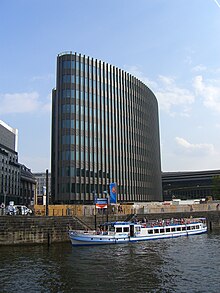Mark Braun (architect)
Mark Braun (* 1962 in Gescher ; † June 11, 2008 in Berlin) was a German architect . His most famous and at the same time most striking buildings are in a prominent Berlin location.
Live and act
Braun completed a degree in architecture from 1982 to 1989 at RWTH Aachen University with a diploma. From 1987 to 1990 he gained professional experience as a participant in various competitions , including in Düsseldorf, Aachen, Kassel and Duisburg. He applied to Norman Foster , was accepted and worked in the Norman Foster + Partners office in London from 1990 to 1999 .
His greatest task from 1992 to 1999 was project management for the renovation of the Berlin Reichstag . Some say in this context that he was the actual creator of the glass dome .
After completing the work on the Reichstag, Mark Braun set up his own office. His construction projects in Berlin and the surrounding area include the Fehrbelliner Höfe, townhouses in Friedrichswerder , the Upper School Center for Information and Medical Technology (OSZ IMT), the Military History Research Office in Potsdam, row houses in Kladow and the renovation and conversion of the “ Rostlaube ” building complex at the Free University of Berlin in Berlin-Dahlem .
In addition to the Reichstag, two more of his buildings are in a prominent location in Berlin-Mitte : the SAP headquarters on Rosenthaler Strasse (near Hackescher Markt ) and the high-rise office building on the so-called " Spreedreieck " area in Friedrichstrasse (between Friedrichstrasse station and the Spree ) . Mies van der Rohe had already made a famous glass house design for the property in 1921. Based on this, Braun designed an office tower that is divided into two parts on the outside and connected on the inside with curved glass facades. The implementation was delayed again and again due to legal disputes, and changes had to be made several times. He fought unsuccessfully for his originally much higher design.
Because of his liver cancer , Braun closed his office at the end of February 2008. He died three and a half months later at the age of 46, before the Spreedreieck building was completed.
The Frankfurter Allgemeine Zeitung characterized Braun's architectural language as "cool and technical, matter-of-factly sober and smooth". He preferred glass, steel and aluminum and his color palette was dominated by "silver-gray with a few strong contrasts". The architecture portal BauNetz sums it up : "With his buildings, Mark Braun committed himself to a dynamic, uncompromisingly modern architectural language."
Fonts
- Multifunctional service park Duisburg Inner Harbor - New inner-city dimensions for work, living, leisure, urban design, energy use and environmental protection. In: Gunther Annen, Michael Becker, Mark Braun (eds.): Ecological renewal of an industrial landscape (= series of publications by the German Association for Water Management and Cultural Building ; Issue 108). Kommissionsvertrieb Wirtschafts- und Verlagsgesellschaft Gas und Wasser, Bonn 1994, ISBN 3-922671-44-6 , pp. 141-148.
literature
- Reichstag Berlin, Sir Norman Foster and Partners. Exhibition August 1994, Aedes Gallery and Architecture Forum . Aedes, Berlin 1994.
Individual evidence
- ↑ a b Helene Wentker: His spurs stay in Berlin. In: azonline.de. Verlag J. Fleißig GmbH & Co. KG, July 4, 2008, accessed on April 30, 2020 (the indication “Berlin” in the book Baukunst im Archiv is incorrect).
- ↑ a b c d Eva-Maria Barkhofen (Ed.): Architecture in the archive. The collection of the Academy of Arts . DOM Publishers, Berlin 2016, ISBN 978-3-86922-492-3 , Mark Braun, p. 66-73 .
- ^ TH: There is a glass dome on top of the Reichstag. The Bundestag's council of elders opted for a model by the architect Foster . In: New Time . National daily newspaper. 151 B / 1994, July 1, 1994, p. 1 .
- ↑ a b rha: architect of the new Reichstag: Mark Brown is dead. In: welt.de. June 17, 2008, accessed April 30, 2020 .
- ^ Markus Eisenhauer: Mark Braun (born 1962). In Berlin, however, “think big” means “stick to the eaves”. In: tagesspiegel.de. December 5, 2008, accessed April 30, 2020 .
- ↑ Gerwin Zohlen: The architect's cross . In: Frankfurter Allgemeine Zeitung . No. 84/2008 , April 10, 2008, features section , p. 42 .
- ↑ Too early. On the death of Mark Braun. In: baunetz.de. Heinze GmbH, June 11, 2008, accessed April 30, 2020 .
Web links
- SAP office building in Berlin, Rosenthaler Straße on the website of the Senate Department for Urban Development and Housing
- Mark Braun Archive in the archive of the Academy of Arts , Berlin
| personal data | |
|---|---|
| SURNAME | Braun, Mark |
| BRIEF DESCRIPTION | German architect |
| DATE OF BIRTH | 1962 |
| PLACE OF BIRTH | Gescher |
| DATE OF DEATH | June 11, 2008 |
| Place of death | Berlin |

